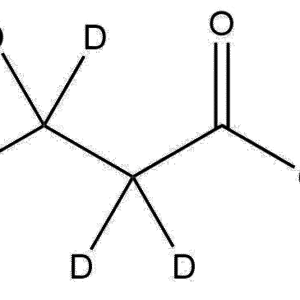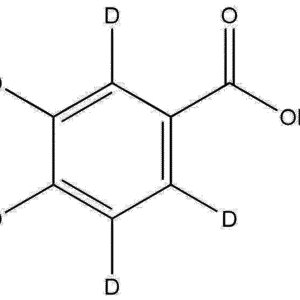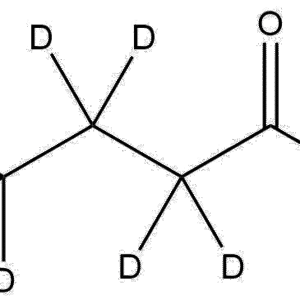OVERVIEW
2-Pyrazine-d₃-carboxylic Acid is a selectively deuterated derivative of 2-pyrazinecarboxylic acid, a heteroaromatic compound belonging to the pyrazine family. In this isotopically labeled version, three hydrogen atoms on the pyrazine ring are replaced by deuterium, leading to a +3 Da increase in molecular mass while maintaining the same structural, chemical, and reactive properties as its non-deuterated analogue.
This compound is widely utilized as a stable isotope-labeled standard in analytical chemistry and biochemical research. The deuterium labeling enhances analytical precision in mass spectrometry (MS), nuclear magnetic resonance (NMR), and tracer studies, enabling researchers to distinguish between labeled and unlabeled species. Due to its aromatic nitrogen-containing structure, it is also an important intermediate for studying oxidation, reduction, and heterocyclic substitution reactions in synthetic organic and pharmaceutical chemistry.
CHEMICAL INFORMATION
-
Name: 2-Pyrazine-d₃-carboxylic Acid
-
Molecular Formula: C₅HD₃N₂O₂
-
Molecular Weight: 127.12 g/mol
-
CAS Number: 1794791-32-4
-
Isotopic Enrichment: ≥ 98 atom % D
-
Chemical Class: Deuterated heteroaromatic carboxylic acid; nitrogen heterocycle
-
Functional Groups: Carboxylic acid (-COOH), aromatic ring with nitrogen atoms
-
Stability: Stable under ambient conditions; deuterium substitution improves isotopic robustness
APPLICATIONS of 2-Pyrazine-d3-carboxylic Acid | CAS 1794791-32-4
-
Mass Spectrometry (MS) Internal Standard:
2-Pyrazine-d₃-carboxylic Acid serves as a deuterated internal standard for LC-MS and GC-MS quantification of pyrazinecarboxylic acid and related derivatives in chemical and biological samples. The +3 Da isotopic shift provides unambiguous mass separation, improving analytical accuracy and reproducibility. -
NMR Spectroscopy:
The deuterium substitution reduces background proton signals, making the compound ideal for use in NMR-based structural and kinetic studies. It enables high-resolution analysis of hydrogen–deuterium exchange, isotope effects, and heteroaromatic ring interactions. -
Pharmaceutical and Biochemical Research:
Pyrazinecarboxylic acid and its derivatives are of pharmaceutical significance due to their role as intermediates in the synthesis of antitubercular agents, flavoring compounds, and coordination complexes. The deuterated form, 2-Pyrazine-d₃-carboxylic Acid, aids in metabolic and pharmacokinetic studies, allowing accurate tracking of drug absorption and degradation pathways. -
Stable Isotope Labeling Studies:
Employed in tracer experiments and mechanistic studies, this compound assists in identifying metabolic routes and reaction intermediates involving pyrazine-containing molecules. Its stable deuterium incorporation provides reliable data for isotope effect analyses. -
Analytical Method Validation:
Used as a calibration and reference compound for validating quantitative analytical methods, especially when analyzing nitrogen-containing heterocycles in complex mixtures.
ADVANTAGES of 2-Pyrazine-d3-carboxylic Acid | CAS 1794791-32-4
-
High isotopic enrichment (≥ 98 atom % D) ensures clear mass differentiation.
-
Chemically identical to the non-deuterated compound, maintaining consistent reactivity and solubility.
-
Ideal for quantitative LC-MS, GC-MS, and NMR applications.
-
Provides superior accuracy in isotope-dilution analyses and tracer studies.
-
Stable, non-radioactive, and environmentally safe isotopic label.
-
Enhances sensitivity and specificity in analytical determinations.
HANDLING
2-Pyrazine-d₃-carboxylic Acid is considered a low-toxicity compound, but standard laboratory precautions should be followed:
-
Avoid inhalation of dust or vapors and contact with eyes or skin.
-
Use personal protective equipment such as gloves, goggles, and lab coats.
-
Handle in a fume hood when working with large quantities or volatile solvents.
-
Store in sealed containers away from oxidizing agents, acids, and bases.
-
In case of skin or eye contact, rinse immediately with water and seek medical attention if irritation develops.
QUALITY & SPECIFICATION
Each batch of 2-Pyrazine-d₃-carboxylic Acid undergoes rigorous quality testing to confirm isotopic purity, chemical identity, and structural integrity. Characterization typically includes:
-
¹H / ²H NMR Spectroscopy: Verification of deuteration levels and substitution positions.
-
High-Resolution Mass Spectrometry (HRMS): Confirmation of isotopic distribution and molecular weight.
-
Infrared (IR) Spectroscopy: Functional group verification and purity check.
-
Chemical Purity: ≥ 98 %
-
Isotopic Enrichment: ≥ 98 atom % D
A Certificate of Analysis (COA) is supplied with each batch, documenting analytical validation and isotopic enrichment data.
SUMMARY
2-Pyrazine-d₃-carboxylic Acid (CAS 1794791-32-4) is a high-purity, deuterium-labeled aromatic carboxylic acid designed for use in advanced analytical, spectroscopic, and biochemical research. Retaining the same structure and chemical characteristics as native 2-pyrazinecarboxylic acid, its deuterium incorporation enhances performance in isotope-dilution MS, NMR, and tracer-based investigations. With its excellent isotopic stability and analytical reliability, 2-Pyrazine-d₃-carboxylic Acid is an indispensable tool for researchers engaged in metabolic pathway analysis, reaction mechanism studies, and quantitative method development.
Learn more about,
Deuterated Polymers: A Cornerstone Guide to Synthesis, Applications, and Future Trends
Availability of All the Deuterated Chemicals at ResolveMass Laboratories Inc.
ResolveMass Laboratories: Leading Deuterated Chemical Synthesis Company in the United States.
Deuterated Internal Standards for LC-MS: Selection & Custom Synthesis
How to Choose the Right Deuterated Labelled Chemical Synthesis Company in Canada
How to Choose the Right Deuterium Labelled Compounds Supplier for Your Lab
Deuterium-Labelled Compounds — Synthesis, Applications & Ordering





Reviews
There are no reviews yet.